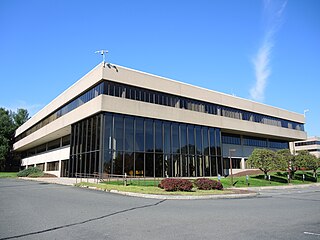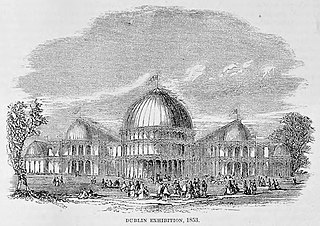
The 1850s was a decade of the Gregorian calendar that began on January 1, 1850, and ended on December 31, 1859.

The World's Columbian Exposition, also known as the Chicago World's Fair, was a world's fair held in Chicago from May 5 to October 31, 1893, to celebrate the 400th anniversary of Christopher Columbus's arrival in the New World in 1492. The centerpiece of the Fair, held in Jackson Park, was a large water pool representing the voyage that Columbus took to the New World. Chicago won the right to host the fair over several competing cities, including New York City, Washington, D.C., and St. Louis. The exposition was an influential social and cultural event and had a profound effect on American architecture, the arts, American industrial optimism, and Chicago's image.

A world's fair, also known as a universal exhibition or an expo, is a large global exhibition designed to showcase the achievements of nations. These exhibitions vary in character and are held in different parts of the world at a specific site for a period of time, typically between three and six months.

The Louisiana Purchase Exposition, informally known as the St. Louis World's Fair, was an international exposition held in St. Louis, Missouri, United States, from April 30 to December 1, 1904. Local, state, and federal funds totaling $15 million were used to finance the event. More than 60 countries and 43 of the then-45 American states maintained exhibition spaces at the fair, which was attended by nearly 19.7 million people.

The Centennial International Exhibition, officially the International Exhibition of Arts, Manufactures, and Products of the Soil and Mine, was held in Philadelphia from May 10 to November 10, 1876. It was the first official world's fair to be held in the United States, and coincided with the centennial anniversary of the Declaration of Independence's adoption in Philadelphia on July 4, 1776.

The Great Exhibition of the Works of Industry of All Nations, also known as the Great Exhibition or the Crystal Palace Exhibition, was an international exhibition that took place in Hyde Park, London, from 1 May to 15 October 1851. It was the first in a series of World's Fairs, exhibitions of culture and industry that became popular in the 19th century. The event was organised by Henry Cole and Prince Albert, husband of Victoria, Queen of the United Kingdom.

The Exposition Universelle of 1855, better known in English as the 1855 Paris Exposition, was a world's fair held on the Champs-Élysées in Paris, France, from 15 May to 15 November 1855. Its full official title was the Exposition Universelle des produits de l'Agriculture, de l'Industrie et des Beaux-Arts de Paris 1855. It was the first of ten major expositions held in the city between 1855 and 1937. Nowadays, the exposition's sole physical remnant is the Théâtre du Rond-Point des Champs-Élysées, designed by architect Gabriel Davioud, which originally housed the Panorama National.

The Exposition Universelle of 1900, better known in English as the 1900 Paris Exposition, was a world's fair held in Paris, France, from 14 April to 12 November 1900, to celebrate the achievements of the past century and to accelerate development into the next. It was the sixth of ten major expositions held in the city between 1855 and 1937. It was held at the esplanade of Les Invalides, the Champ de Mars, the Trocadéro and at the banks of the Seine between them, with an additional section in the Bois de Vincennes, and it was visited by more than fifty million people. Many international congresses and other events were held within the framework of the exposition, including the 1900 Summer Olympics.

Modern architecture, also called modernist architecture, was an architectural movement and style that was prominent in the 20th century, between the earlier Art Deco and later postmodern movements. Modern architecture was based upon new and innovative technologies of construction ; the principle functionalism ; an embrace of minimalism; and a rejection of ornament.

Elisha Graves Otis was an American industrialist and founder of the Otis Elevator Company. In 1853, he invented a safety device that prevents elevators from falling if the hoisting cable fails.

Otis Worldwide Corporation is an American company that develops, manufactures and markets elevators, escalators, moving walkways, and related equipment.

The Exposition Universelle of 1889, better known in English as the 1889 Paris Exposition, was a world's fair held in Paris, France, from 5 May to 31 October 1889. It was the fifth of ten major expositions held in the city between 1855 and 1937. It attracted more than thirty-two million visitors. The most famous structure created for the exposition, and still remaining, is the Eiffel Tower.

The Vulcan statue is the largest cast iron statue in the world, and is the city symbol of Birmingham, Alabama, United States, reflecting its roots in the iron and steel industry. The 56-foot (17 m) tall statue depicts the Roman god Vulcan, god of the fire and forge, with ironworking equipment. It was created as Birmingham's entry for the Louisiana Purchase Exposition in St. Louis, Missouri. While it is the world's largest made of iron, it is also among the nation's tallest statues of any kind.

The Great Industrial Exhibition in 1853 was held in Dublin, Ireland. In its day, it was the largest international event to be held in Ireland. The Irish Industrial Exhibition Building, located on the grounds of Leinster House, housed the entire fair. It lasted from 12 May to 31 October, Queen Victoria accompanied by the Prince Consort and the Prince of Wales, paid an official visit on 29 August.

New York Crystal Palace was an exhibition building constructed for the Exhibition of the Industry of All Nations in New York City in 1853, which was under the presidency of the mayor Jacob Aaron Westervelt. The building stood on a site behind the Croton Distributing Reservoir in what is now Bryant Park. It was destroyed by fire on October 5, 1858.
The Otis family is a Boston Brahmin family from Massachusetts best known for its involvement in early American politics.

The Latting Observatory was a wooden tower in New York City built as part of the 1853 Exhibition of the Industry of All Nations, adjoining the New York Crystal Palace. It was located on the North side of 42nd Street between Fifth Avenue and Sixth Avenue across the street from the site of present-day Bryant Park. Conceived by Waring Latting and designed by architect William Naugle, the observatory was an octagonally-based, iron-braced wooden tower 315 feet (96 m) high adjoining the Crystal Palace, with landings at three levels on the structure, allowing visitors to see east into Queens, south into Staten Island, and west into New Jersey. The tower, taller than the spire of Trinity Church at 290 feet (88 m), was the tallest structure in New York City from the time it was constructed in 1853 until it was shortened in 1855. The tower's base was a 75-foot (23 m) square, tapering to a top of 6 to 8 feet. It could handle up to 1,500 people at a time. It burned down in 1856.

The Irish Industrial Exhibition was a world's fair held in Cork in 1852, the first to be held in Ireland. It was opened on 10 June by the Lord Lieutenant, the Earl of Eglinton.

The International Exhibition of Arts and Manufactures was a world's fair held in Dublin, Ireland in 1865 attended by almost 1 million visitors.



















